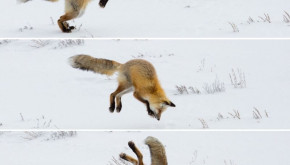

Written by Deborah Perkins, re-posted from her blog. Photo above by skeeze, Pixabay.
We've had a couple of lovely little snow events recently. Good ole' fashioned fluffy snow that sticks and doesn't turn to rain or ice (...yes, please!..). Not only is snow enchantingly beautiful, it also creates a critically important seasonal habitat for shrews, mice, and voles.
As snow falls, air pockets form around stems of plants, rocks, logs, branches, and tree trunks. These dark areas also absorb solar heat and create a warmer environment than the "outside world". These miniature snow caves provide excellent shelter once the snowpack reaches about six inches deep. The technical term for the environment between the surface of the ground and the top of the snowpack is the subnivean zone — from the latin "sub" (under) and "nives" (snow).
Some words are just a joy to use in a sentence, and subnivean is one of my favorite words. The particular arrangement of vowels and consonants in subnivean is just a delight to the ear (and my daughter thinks it sounds like a Harry Potter spell - so there’s that, too…)!
Small mammals use the subnivean zone as their winter living quarters. Some areas are for sleeping, while others are for food storage or elimination (latrines). Elaborate tunnel systems connect these winter "rooms" beneath the insulated, thermal blanket of snow in the subnivean environment.
As we all know, winters in the North can be harsh. For some animals that don't migrate or hibernate, the subnivean zone is their key to survival.
But what if you are predator? How do you survive this period of scarcity and extreme weather? To solve this problem, some of our predators have adapted hunting strategies that allow them to detect the presence and precise movements of the subnivean dwellers.
For example, foxes have developed a fascinating and delightfully fun-to-watch "mousing" behavior. This is a key survival skill for a fox, and involves a combination of their keen stalking and listening skills, as well as their incredible sense of smell. When they detect a mouse or other small mammal under the snow, they will jump high in the air and pounce through the snowpack to capture their prey. The element of surprise is key, and they will fail if their pounce doesn't land in the precise location of the animal. According to one Czechoslovakian researcher, foxes even use the Earth's magnetic field as a "range finder or targeting system". WOW!
Next time you are walking in the winter woods, I invite you to ponder the secret world of the subnivean, and the marvelous adaptations of our wildlife. If you are patient and take your time, you might even uncover some of the secrets of the subnivean for yourself.
As “The Personal Ecologist” and owner of First Light Wildlife Habitats, Deb Perkins co-creates thriving forestland habitats with stewards throughout the Northeast – at any scale.

